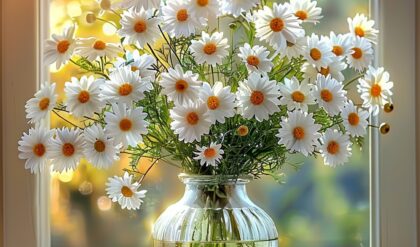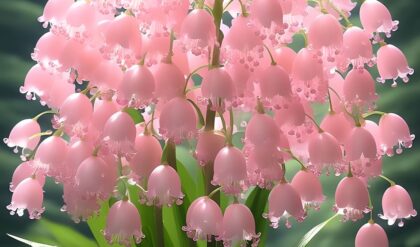Dahlias are the crown jewels of the garden, offering an unparalleled diversity of colors, shapes, and sizes. With over 100 distinctive varieties available, these captivating blooms can transform any garden into a breathtaking floral paradise. This comprehensive guide will explore the most stunning and resilient dahlia varieties, providing you with the knowledge to create an unforgettable display in your own backyard. From the classic elegance of ‘Cafe Au Lait’ to the bold drama of ‘Bishop of Llandaff’, we’ll delve into the characteristics that make these dahlias stand out and offer tips on how to incorporate them into your garden design for maximum impact.

Understanding Dahlia Classifications
Formal Decorative Dahlias
Formal decorative dahlias are characterized by their symmetrical, fully double blooms with flat or slightly curved petals. These dahlias often resemble perfectly sculpted works of art, making them a favorite among gardeners and florists alike.
The ‘Karma Serena’ is a prime example of this class, boasting large, creamy white flowers that add a touch of elegance to any garden. Its sturdy stems make it an excellent choice for cut flower arrangements, allowing you to bring the beauty of your garden indoors.
Another standout in this category is the ‘Thomas Edison’, with its deep purple blooms that seem to glow in the evening light. This variety not only adds a regal touch to your garden but also attracts pollinators, contributing to the overall health of your ecosystem.

Cactus and Semi-Cactus Dahlias
Cactus and semi-cactus dahlias are known for their spiky, pointed petals that give them a star-like appearance. These varieties add texture and interest to your garden, creating a dynamic visual display.
The ‘Nuit d’Ete’ is a stunning cactus dahlia with deep maroon, almost black petals that create a dramatic focal point in any garden setting. Its dark hues contrast beautifully with lighter-colored flowers, making it an essential component of a well-designed color scheme.
For those seeking a more vibrant option, the ‘Karma Fuchsiana’ offers bright pink blooms that seem to dance in the breeze. This semi-cactus variety not only provides a pop of color but also boasts excellent vase life, making it a favorite among cut flower enthusiasts.

Pompon and Ball Dahlias
Pompon and ball dahlias feature small, perfectly round blooms that resemble miniature globes. These charming varieties are perfect for adding whimsy and delicacy to your garden landscape.
The ‘Tiny Treasure’ pompon dahlia, with its petite yellow blooms, is ideal for container gardening or as a border plant. Its compact size belies its prolific blooming habit, ensuring a constant display of cheerful flowers throughout the season.
In the ball dahlia category, the ‘Jowey Mirella’ stands out with its rich, burgundy blooms. This variety combines the formal symmetry of ball dahlias with a deep, sophisticated color, making it a versatile choice for both modern and traditional garden designs.
Selecting Dahlias for Continuous Blooming
Early Season Bloomers
To ensure a garden filled with dahlias from spring through fall, it’s crucial to include early season bloomers in your selection. These varieties kick off the dahlia season, providing color and interest when many other plants are just beginning to wake up.
The ‘Gallery Art Deco’ is an excellent choice for early season blooms. This compact variety produces vibrant orange flowers as early as June, depending on your climate. Its dwarf stature makes it perfect for containers or front-of-border plantings.
Another early bloomer to consider is the ‘Melody Harmony’. With its cheerful yellow petals tipped in soft pink, this variety brings a touch of sunshine to the garden right from the start of the season.

Mid-Season Showstoppers
As summer progresses, mid-season dahlias take center stage, offering a spectacular display during the height of the growing season.
The aforementioned ‘Cafe Au Lait’ is a quintessential mid-season bloomer, producing its iconic large, creamy blooms from mid-summer onwards. This variety’s popularity stems not only from its beauty but also from its versatility in garden design and floral arrangements.
For those seeking a more dramatic mid-season option, the ‘Diva’ lives up to its name with bold, fuchsia-pink blooms that command attention. This variety’s strong stems and long-lasting flowers make it ideal for both garden displays and cut flower bouquets.
Late Season Extenders
To ensure your dahlia display continues well into autumn, incorporating late-season bloomers is essential. These varieties will keep your garden vibrant even as other plants begin to fade.
The ‘Penhill Dark Monarch’ is a stunning late-season dahlia that produces large, deep red blooms with hints of burgundy. Its rich colors complement the changing foliage of autumn, creating a cohesive seasonal display.
Another excellent choice for extending the dahlia season is the ‘Platinum Blonde’. This variety’s pale lavender flowers seem to glow in the soft light of autumn, providing a ethereal quality to your late-season garden.

Dahlias for Specific Garden Styles
Cottage Garden Favorites
Cottage gardens are known for their informal, romantic aesthetics, and certain dahlia varieties are perfect for enhancing this style.
The ‘Bishop of Llandaff’ is a classic choice for cottage gardens, with its vibrant red flowers contrasting beautifully against dark foliage. This variety’s informal growth habit and single to semi-double blooms fit seamlessly into the relaxed cottage garden style.
For a softer look, the ‘Hollyhill Spiderwoman’ offers delicate, spider-like petals in shades of lavender and white. Its airy appearance adds a touch of whimsy to cottage-style plantings.
Modern Landscape Accents
In contemporary garden designs, dahlias can provide structured forms and bold colors that complement minimalist landscapes.
The ‘Sonic Bloom’ dahlia, with its perfectly symmetrical, bright yellow blooms, offers a striking geometric form that suits modern garden aesthetics. Its strong, upright growth habit creates clean lines that echo architectural elements in the landscape.
For a more subdued modern look, the ‘Cafe au Lait Royal’ provides large, structured blooms in soft blush tones. This variety’s sophisticated color palette and impressive size make it an ideal focal point in contemporary garden designs.
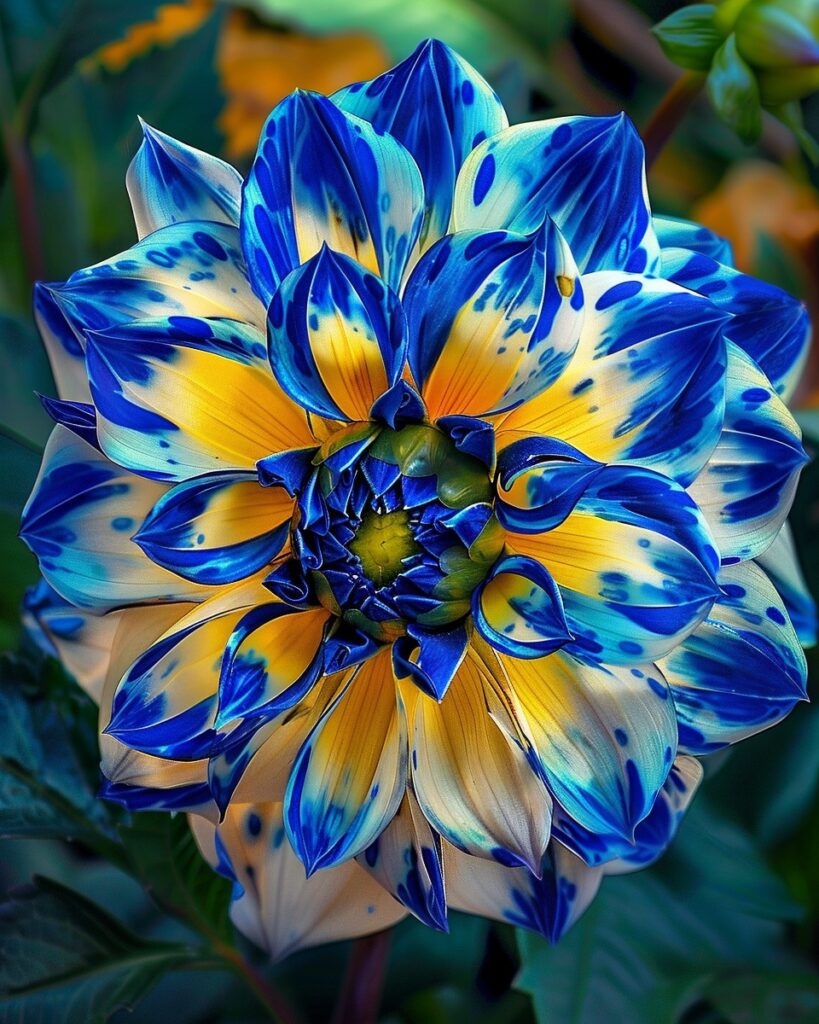
Wildlife-Friendly Varieties
Incorporating dahlias that attract pollinators and beneficial insects can enhance your garden’s ecological value while maintaining its beauty.
The single-flowered ‘Happy Single First Love’ dahlia is not only charming with its pink petals and yellow center but also a favorite among bees and butterflies. Its open flower structure provides easy access to nectar and pollen.
Another wildlife-friendly option is the ‘Honka Fragile’ dahlia. This variety’s star-shaped flowers in pale yellow with red stripes not only add visual interest but also serve as an excellent food source for various pollinators.
Growing Tips for Spectacular Dahlia Displays
Soil Preparation and Planting Techniques
Successful dahlia cultivation begins with proper soil preparation. These plants thrive in well-draining, nutrient-rich soil with a pH between 6.5 and 7.0.
Before planting, amend your soil with compost or well-rotted manure to improve fertility and structure. This organic matter not only provides nutrients but also helps retain moisture without causing waterlogging, which can be detrimental to dahlia tubers.

When planting, choose a location that receives full sun for at least 6 hours a day. Dig holes about 4-6 inches deep and space them according to the variety’s mature size. Place the tubers horizontally with the growing eye facing upward, and cover with 2-3 inches of soil.
Watering and Fertilizing Strategies
Proper watering is crucial for dahlia health and bloom production. Water deeply but infrequently to encourage deep root growth. A good rule of thumb is to provide about 1 inch of water per week, adjusting for rainfall.
Fertilization should begin when the plants are about 8 inches tall. Use a balanced, low-nitrogen fertilizer to promote blooming rather than excessive foliage growth. Apply fertilizer every 3-4 weeks throughout the growing season, being careful not to over-fertilize, which can lead to weak stems and reduced flowering.
Pest and Disease Management
While dahlias are generally hardy, they can fall prey to certain pests and diseases. Regular monitoring is key to catching problems early.
Common pests include aphids, spider mites, and earwigs. For organic control, try introducing beneficial insects like ladybugs or using insecticidal soaps. For fungal issues like powdery mildew, ensure good air circulation by proper spacing and avoid overhead watering.
Implementing a proactive approach, such as removing debris and practicing crop rotation, can significantly reduce the risk of pest and disease issues in your dahlia garden.
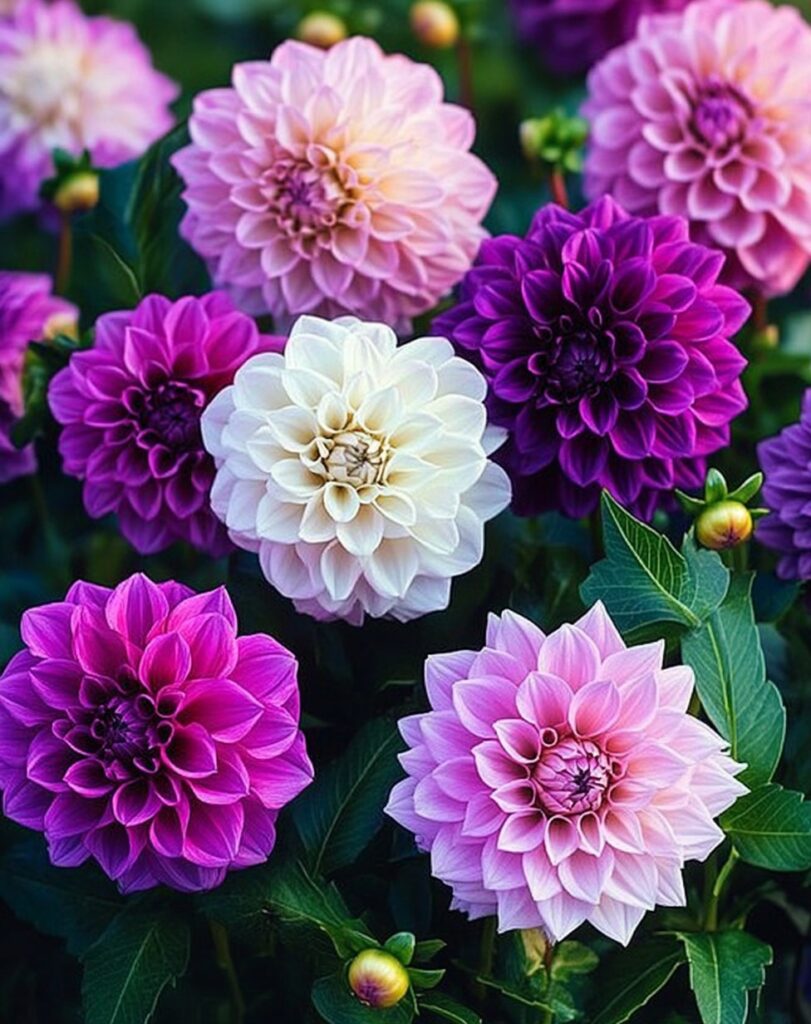
Dahlia Varieties for Cut Flower Arrangements
Long-Lasting Blooms for Vases
Certain dahlia varieties are particularly well-suited for cut flower arrangements due to their long vase life and sturdy stems.
The ‘Cornel Bronze’ is renowned not only for its beautiful bronze-orange blooms but also for its exceptional vase life. When properly conditioned, these flowers can last up to a week in arrangements, making them a favorite among florists and home gardeners alike.
Another excellent choice for cut flowers is the ‘Karma Choc’, with its deep, velvety red blooms. This variety’s strong stems and large flowers create stunning focal points in bouquets, and its rich color adds depth and drama to any arrangement.
Color Combinations for Stunning Bouquets
Creating harmonious color combinations in dahlia bouquets can elevate your floral arrangements from beautiful to breathtaking.
Pairing the soft pink ‘Bracken Rose’ with the deep purple ‘Thomas Edison’ creates a striking contrast that catches the eye. Add in the white ‘Fleurel’ for balance, and you have a sophisticated bouquet that works for any occasion.
For a more vibrant combination, try mixing the bright orange ‘David Howard’ with the magenta ‘Figurine’. Introduce the yellow ‘Kelvin Floodlight’ to this mix for a bouquet that captures the essence of a summer sunset.

Companion Flowers for Dahlia Arrangements
While dahlias are stunning on their own, combining them with complementary flowers can create even more impressive arrangements.
Zinnias make excellent companions for dahlias in both the garden and vase. The ‘Benary’s Giant Mix’ zinnias offer a range of colors that can complement or contrast with your chosen dahlia varieties.
For a softer look, consider pairing dahlias with cosmos. The delicate ‘Cupcake Blush’ cosmos can add a ethereal quality to arrangements featuring bolder dahlia varieties like the ‘Cafe au Lait’ or ‘Penhill Dark Monarch’.
Preserving and Propagating Your Favorite Dahlias
Overwintering Dahlia Tubers
To enjoy your favorite dahlia varieties year after year, proper overwintering of tubers is essential, especially in colder climates.
After the first frost, cut the foliage back to about 6 inches above ground level. Carefully dig up the tuber clumps, being cautious not to damage them. Gently remove excess soil and allow the tubers to dry for a few days in a well-ventilated area.
Once dry, store the tubers in a cool, dark place in containers filled with slightly moist peat moss or vermiculite. Maintain a temperature between 40-50°F (4-10°C) throughout the winter months to prevent sprouting or rotting.
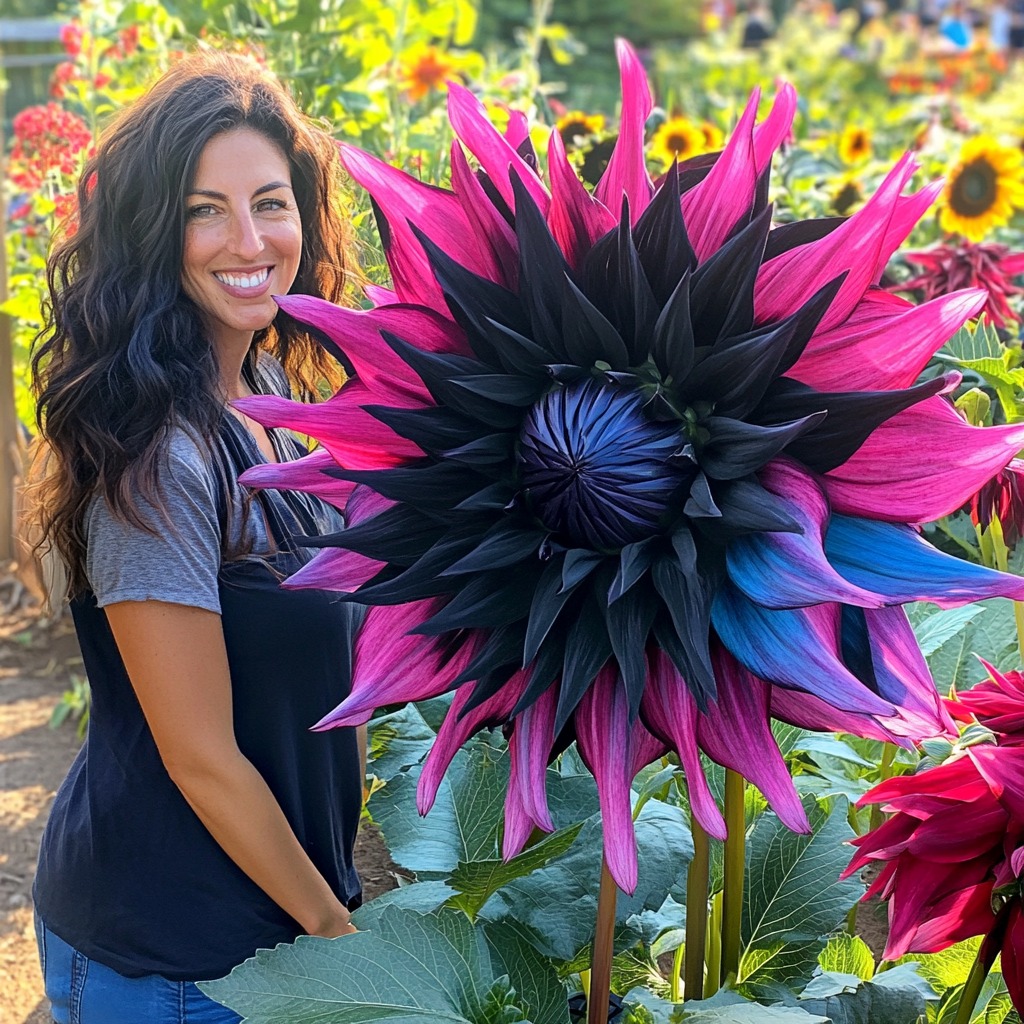
Dividing and Propagating Dahlia Tubers
Dividing dahlia tubers not only helps rejuvenate your plants but also allows you to increase your collection of favorite varieties.
In spring, before planting, examine your stored tubers. Look for the “eyes” or growth buds near the base of the old stem. Using a clean, sharp knife, divide the tuber clump, ensuring each division has at least one eye and a portion of the old stem attached.
Allow the cut surfaces to dry for a day before planting or storing. This process of division can significantly increase your dahlia stock, allowing you to expand your garden or share with fellow enthusiasts.
Saving and Storing Dahlia Seeds
While most hybrid dahlias don’t come true from seed, saving and growing dahlia seeds can be an exciting way to potentially create new varieties.
To save seeds, allow some flowers to mature fully on the plant until the petals dry and fall off. Collect the seed heads and dry them further indoors. Once completely dry, separate the seeds from the chaff and store them in paper envelopes in a cool, dry place.
When planting, sow the seeds indoors about 4-6 weeks before the last frost date. Transplant the seedlings outdoors after all danger of frost has passed. Keep in mind that plants grown from seed may take up to two years to bloom, but the potential for unique new varieties makes this a rewarding process for dedicated dahlia enthusiasts.
Conclusion
Exploring the world of dahlias opens up a realm of endless possibilities for garden design and floral creativity. From the classic elegance of formal decorative varieties to the whimsical charm of pompon dahlias, there’s a perfect bloom for every garden style and personal preference. By carefully selecting varieties for continuous blooming, considering specific garden styles, and mastering growing techniques, you can create a dahlia display that captivates throughout the growing season. Whether you’re cultivating these beautiful flowers for garden enjoyment, cut flower arrangements, or the excitement of propagation, the diverse world of dahlias offers something for every level of gardener. As you embark on your dahlia journey, remember that each variety brings its own unique charm and potential to your garden, contributing to a living tapestry of color, form, and natural beauty. With the knowledge gained from this guide, you’re well-equipped to explore the 100 best dahlia varieties and beyond, creating your own personal paradise of these remarkable flowers.


